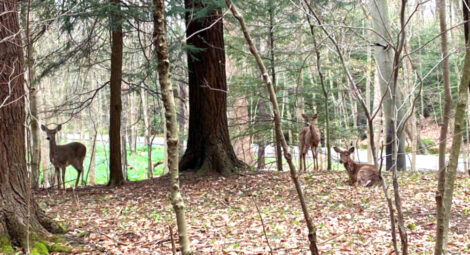Deer pose bigger threat than hunters, officials say
BOARDMAN — Residents attending township trustees meetings continue to raise their concerns about deer hunting on Mill Creek MetroParks property, although state law gives trustees no authority over hunting.
Boardman police also can only address matters that pose an immediate risk to public safety.
Following Monday’s regular meeting, police Chief Todd Werth said that while his department will respond to any threat to public safety, residents also should better understand what the risks really are.”You’re more likely to be hurt in a deer-related crash than by anything having to do with hunting,” Werth said.
Local experts from the Ohio Department of Natural Resources and data from the Ohio State Highway Patrol say Werth is right.
“Most hunters are exceptionally responsible because they recognize it’s a privilege to be able to hunt,” said Tom Frank, Mahoning County wildlife officer with ODNR.
Frank has been in the position for 16 years. In that time, he’s handled every case involving property damage or personal injury caused by a hunter.
There have been 14, including self-inflicted injuries by hunters. As Frank explains, that represents an astronomically low rate of hunting-related incidents.
“We average about 2,000 deer harvested a year, so that means for sure there was a hunter in the field in Mahoning County 2,000 times each year, and out of that there have been 14 total incidents,” he said. “That comes out to about .04%.”
Frank said the overwhelming majority of hunters are conscientious and care about the safety of others around them in addition to their own and each other’s.
“By and large, our hunters are exceptionally responsible,” he said. “Most hunters, with incidents like this, when I’m only minutes into the investigation they say, ‘If that was me, I’ll make it right,’ or ‘let me speak with the homeowner.'”
Frank said one hunter bought the homeowner a turkey or a ham and the two developed something of a friendship out of the incident.
That is not to say bad things do not happen or that bad actors are not involved.
The worst case over his tenure, Frank said, was a person who had caused trouble in the past.
“That gentleman shot a deer, the bullet went through the deer, across the road, and went into a house and blew a hole in a guy’s foot,” Frank said.
He was referring to Kasen Smith of Sebring, who was sentenced in August 2022 to two years in prison for the December 2020 incident. Smith pleaded guilty in Mahoning County Common Pleas Court to discharging a firearm on or near prohibited premises, with a mandatory one-year gun specification, injuring a person while hunting, hunting without permission and violating hunting ordinances.
The gunfire was prohibited because of its proximity to Market Street and a nursing home. The gunshot crossed Market Street.
“We’d had five other issues with this guy in the past, and he took no responsibility,” Frank said. “Never tried to make it right or speak to the homeowner.”
In another incident, Frank said, the young hunter also had a bad attitude and was only saved by his attorney’s advice.
Frank said the hunter shot at the ground in front of a deer standing in front of a house to scare the deer away from the home so he could take a legal shot at it. The bullet ricocheted off the ground, went through the resident’s garage door and struck a refrigerator inside the garage.
“Not the crime of the century, but he was negligent in his thinking and I was disappointed in his attitude,” Frank said. “The only reason that case ended in what I would call an acceptable manner is because his attorney was smart enough to get ahead of it. He took responsibility because he was advised to do so.”
Frank said there were four incidents where a bullet came up off the ground and caused property damage.
Frank said only two other incidents involved injuries to humans. One was a self-inflicted wound to a hunter’s foot after he accidentally tripped the trigger as he approached a deer he had just shot. In the other case, a bullet went through a window and the breaking glass caused a minor cut to a child’s head. In another case, a hunter mistook a dog for a coyote but the dog survived the wound.
Ken Fry is an outdoor skills specialist at ODNR. He said that to avoid or minimize the risk of such incidents, all Ohio hunters must pass a hunter education course.
Between that and state laws that prohibit firing across roads and in the direction of homes, requirements to wear orange vests or clothing in the field, and limits on the number of rounds a weapon can hold at one time, Fry said the state and Ohio hunters have worked to make the pastime much safer.
Fry wants Ohioans to feel good about the sport or at least feel safe about those hunters, wherever they may be plying their craft.
“A while ago, the National Shooting Sports Foundation compiled a list of the safest sports, in terms of injuries,” he said. “Archery was right behind table tennis, and hunting is up in the top 20. The number of people who participate in hunting compared to the actual number of incidents, it’s a very small amount.”
Hunters also have to abide by restrictions governing where they can hunt and when. If they are on private property, they must not only have an Ohio hunting license but also a certificate of written permission from the property owner.
CAR VS. DEER
The statistically low risk of damage or injury from hunting is one part of the picture. What about the deer-involved crashes, though?
The Ohio State Highway Patrol crash dashboard, available online, shows stats for any number of variables, going back several years.
The dashboard shows there have been 27,167 motor vehicle crashes in Mahoning County since Jan 1. 2020, through Monday. Of those, 1,878 have been caused by deer.
State Route 11 has seen the most deer-related crashes, with 216, closely followed by Interstate 76, with 210. Interstate 680, 168; U.S. 224, 150; and U.S. Route 62, 104; round out the top five.
Since 2020, there have been 10 deer-related crashes in Mahoning County that resulted in serious injury, though no fatalities. There have been 40 fatalities from deer-related crashes statewide over the past five years.
There have been 66 that resulted in minor injuries and 41 possible injuries, and of the 1,878 crashes involving deer, 92% of them resulted in property damage.
Deer accidents are much more common during mating season, which runs through October and November, and sometimes carries over into December. Though this overlaps with hunting season, Frank said the data shows mating, and not hunting, drives the increase in crashes.
By Frank’s count, there is less than one hunting-related incident of property damage or injury per year in Mahoning County (0.875). Whereas, deer have caused nearly 1,900 crashes over the past five years — more than 375 per year — 98% of which result in injury and / or property damage.
While stats on the dashboard show that deer-related crashes in the county have gone up in the past couple of years, since the Mill Creek MetroParks hunting began, Frank said it is important to note that in the areas of Boardman where hunters have been active, there is a noticeable decrease in dead deer on the road.
“When you drive along 224, Tippecanoe and Western Reserve, the amount of dead deer from October to now is down,” he said.
Fry said hunting is also Mahoning County’s only way of controlling the deer population.
“White-tail deer do not have a natural predator in this area, so without hunting, the population gets out of control,” he said. “You then end up with more deer causing car accidents and fatalities from that, and you get sick deer populations. There’s also the nuisance factor for people who enjoy outdoor planting and gardening, they have to work harder to protect their gardens.”



